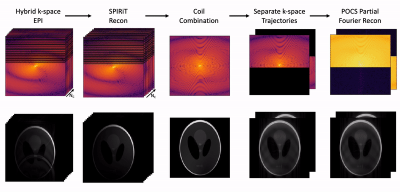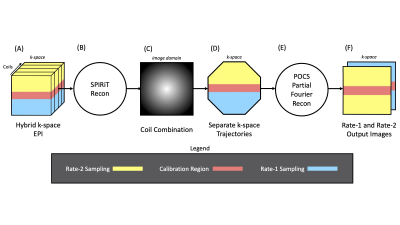Tyler E Cork1,2, Matthew J Middione1, Michael Loecher1, Kévin J Moulin1, John M Pauly3, and Daniel B Ennis1,4
1Radiology, Stanford University, Stanford, CA, United States, 2Bioengineering, Stanford University, Stanford, CA, United States, 3Electrical Engineering, Stanford University, Stanford, CA, United States, 4Radiology, Veterans Affairs Health Care System, Palo Alto, CA, United States
1Radiology, Stanford University, Stanford, CA, United States, 2Bioengineering, Stanford University, Stanford, CA, United States, 3Electrical Engineering, Stanford University, Stanford, CA, United States, 4Radiology, Veterans Affairs Health Care System, Palo Alto, CA, United States
In preliminary simulations using a numerical phantom, an image recon pipeline was outlined to provide 2 images from 1 data acquisition. The data acquisition strategy, HyKE, suggests similar SNR efficiency to averaged acquisitions with the possibility to perform self-distortion correction

The
workflow of the HyKE image reconstruction pipeline implemented
with the BART phantom.
The first row displays the k-space. The second row shows the corresponding images. The
numerical phantom was retrospectively subsampled with the Hybrid k-space EPI
sampling pattern (column 1) for each of the coil images (N = 8). SPIRiT
was run for 20 iterations (column 2) followed by coil combination (column 3). The phantom then was split
into two separate k-spaces (column 4). A POCS Partial Fourier image reconstruction (column 5) ran for 10
iterations resulting in the two reconstructed images.

A
schematic of the image reconstruction pipeline for the HyKE approach. (A) The hybrid k-space EPI incorporates several reconstructions
techniques, including (B) SPIRiT,
(C) conjugate coil combination from the coil sensitivity maps, (D) separating
the different sampling k-space trajectories, and a (E) POCS partial Fourier reconstruction, in order to acquire
(F) two separate images from one hybrid EPI acquisition. The resultant output
images have multiple advantages; such as accelerated imaging and the possibility to characterize
EPI distortion in a single scan.
